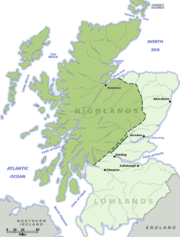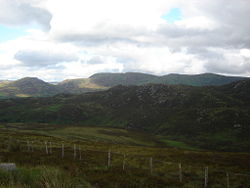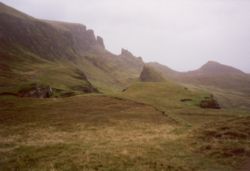Scottish Highlands
2008/9 Schools Wikipedia Selection. Related subjects: Geography of Great Britain
The Scottish Highlands ( Scottish Gaelic: A' Ghàidhealtachd, Scots: Hielans) include the rugged and mountainous regions of Scotland north and west of the Highland Boundary Fault, although the exact boundaries are not clearly defined, particularly to the east. The Great Glen divides the Grampian Mountains to the southeast from the Northwest Highlands. The Highlands are popularly described as one of the most scenic regions of Europe.
The area is generally sparsely populated, with many mountain ranges dominating the region, and includes the highest mountain in the British Isles, Ben Nevis. Before the 19th century however the Highlands was home to a much larger population, but due to a combination of factors including the outlawing of the traditional Highland way of life following the Second Jacobite Rising, the infamous Highland Clearances, and mass migration to urban areas during the Industrial Revolution, the area is now one of the most sparsely populated in Europe. The average population density in the Highlands and Islands is lower than that of Sweden, Norway, Papua New Guinea and Argentina.
The Highland Council is the administrative body for much of the Scottish Highlands, with its administrative centre at Inverness. However the Highlands also includes parts of the council areas of Aberdeenshire, Angus, Argyll and Bute, Moray, Perth and Kinross, and Stirling. Although the Isle of Arran administratively belongs to North Ayrshire, its northern part is generally regarded as part of the Highlands.
Culture
Culturally the area is very different from the Scottish Lowlands. Most of the Highlands fall into the region known as the Gàidhealtachd, which was, within the last hundred years, the Gaelic-speaking area of Scotland. The terms are sometimes used interchangeably but have different meanings in their respective languages. Highland English is also widely spoken.
Some similarities exist between the culture of the Highlands and that of Ireland: examples include the Gaelic language, sport ( shinty, hurling), and Celtic music.
Religion
The Scottish Reformation, which began in the Lowlands, achieved only partial success in the Gaelic-speaking Highlands. Roman Catholicism remained strong in much of the Highlands, aided by Irish Franciscan missionaries who regularly came to the area to celebrate Mass, as they were culturally and ethnically entwined. The Highlands are often described as the last bastion of Roman Catholicism in Great Britain, with significant strongholds such as Moidart, Morar, South Uist and Barra. The Scottish Highlanders' strong Catholicism led to much of their historical antipathy towards the Protestant English. This was in contrast to the Lowland Scots, most of whom converted to Protestantism and thus were more willing to unite with the English to create the Kingdom of Great Britain. On the other hand, some Outer Hebrides islands (like Lewis and Harris) have large populations belonging to the Free Church of Scotland or the Free Presbyterian Church of Scotland.
Historical geography
In traditional Scottish geography, the Highlands refers to that part of Scotland north-west of the Highland Boundary Fault, which crosses mainland Scotland in a near-straight line from Dumbarton to Stonehaven. However the flat coastal lands that occupy parts of the counties of Nairnshire, Morayshire, Banffshire and Aberdeenshire are excluded from most definitions as they do not share the distinctive geographical and cultural features of the rest of the Highlands. The north-east of Caithness, Orkney and Shetland are also often excluded from the Highlands, although the Hebrides are usually included. This definition of the Highland area differed from the Lowlands by language and tradition, having preserved Gaelic speech and customs centuries after the anglicization of the latter; the result of which led to a growing perception of a divide with the cultural distinction between Highlander and Lowlander first noted towards the end of the 14th century. In Aberdeenshire, the boundary between the Highlands and the Lowlands is not well defined. There is a stone beside the A93 road near the village of Dinnet on Royal Deeside which states 'You are now in the Highlands', although there are areas of Highland character to the east of this point.
A much wider definition of the Scottish Highlands is that used by the Scotch Whisky industry. Highland Single Malts are produced at distilleries north of an imaginary line between Dundee and Greenock , thus including all of Aberdeenshire and Angus.
Inverness is traditionally regarded as the Capital of the Highlands, although less so in the Highland parts of Aberdeenshire, Angus, Perthshire and Stirlingshire which look more to cities such as Aberdeen, Perth, Dundee and Stirling as their commercial centres. Under some of the wider definitions in use, Aberdeen could be considered the largest city in the Highlands, although it does not share the same recent gaelic cultural history typical of the Highlands proper.
Highland council area
The Highland Council area, created as one of the local government regions of Scotland, has been a unitary council area since 1996. The council area excludes a large chunk of the southern and eastern Highlands, and the Western Isles, but includes Caithness. Highlands is sometimes used, however, as a name for the council area, as in Highlands and Islands Fire and Rescue Service. Northern, as in Northern Constabulary, is also used to refer to the area covered by the fire and rescue service. This area consists of the Highland council area and the island council areas of Orkney, Shetland and the Western Isles.
Highland council signs in the Pass of Drumochter, between Glen Garry and Dalwhinnie, saying "Welcome to the Highlands", are still regarded as controversial.
Highlands and Islands
Much of the Scottish Highlands area overlaps the Highlands and Islands area. An electoral region called Highlands and Islands is used in elections to the Scottish Parliament: this area includes Orkney and Shetland, as well as the Highland Council local government area, the Western Isles and most of the Argyll and Bute and Moray local government areas. Highlands and Islands has, however, different meanings in different contexts. It means Highland (the local government area), Orkney, Shetland, and the Western Isles in Highlands and Islands Fire and Rescue Service. Northern, as in Northern Constabulary, refers to the same area as that covered by the fire and rescue service.
Historical crossings
Since prehistoric times there have been a number of crossings from the Scottish Lowlands to the Highlands. A number of these routes are traversals of the Mounth, a spur of mountainous land that extends from the higher inland range to the North Sea slightly north of Stonehaven. Some of the most well known and historically important trackways are the Causey Mounth, Elsick Mounth, Cryne Corse Mounth and Cairnamounth.
Geology
The Scottish Highlands lie to the north and west of the Highland Boundary Fault, which runs from Arran to Stonehaven. This part of Scotland is largely composed of ancient rocks from the Cambrian and Precambrian periods which were uplifted during the later Caledonian Orogeny. Smaller formations of Lewisian gneiss in the north west are up to 3,000 million years old and amongst the oldest found anywhere on Earth. These foundations are interspersed with many igneous intrusions of a more recent age, the remnants of which have formed mountain massifs such as the Cairngorms and Skye Cuillin. A significant exception to the above are the fossil-bearing beds of Old Red Sandstones found principally along the Moray Firth coast. The Great Glen is a rift valley which divides the Grampian Mountains to the southeast from the Northwest Highlands.
The entire region was covered by ice sheets during the Pleistocene ice ages, save perhaps for a few nunataks. The complex geomorphology includes incised valleys and lochs carved by the action of mountain streams and ice, and a topography of irregularly distributed mountains whose summits have similar heights above sea-level, but whose bases depend upon the amount of denudation to which the plateau has been subjected in various places.
Towns and villages
- Aberfeldy, Aboyne, Alness, Altnaharra, Applecross, Arisaig, Arrochar, Aultbea, Aviemore
- Back of Keppoch, Ballachulish, Ballater, Banavie, Banchory, Beauly, Bettyhill, Blair Atholl, Boat of Garten, Braemar, Bridge of Orchy
- Cannich, Carrbridge, Coldbackie, Cammachmore, Contin, Cookney, Corpach, Crianlarich, Cromarty, Culbokie, Culloden
- Dalmally, Dalwhinnie, Dingwall, Dornie, Dornoch, Dulnain Bridge, Durness
- Evanton
- Farr, Fort Augustus, Fort William, Fortrose
- Gairloch, Glencoe, Glenelg, Grantown-on-Spey Glenfinnan
- Inveraray, Invermoriston, Inverness
- Killin, Kilmartin, Kingussie, Kinlocheil, Kinlochleven, Kinlochewe, Kinloch Rannoch, Kyle of Lochalsh
- Laggan, Lochailort, Lochcarron, Lochinver, Lochgoilhead, Lochearnhead, Lochgilphead
- Mallaig, Maryculter, Morar, Muchalls, Muir of Ord
- Nairn, Netherley, Newtonmore, North Connel, North Ballachulish, Nethy Bridge
- Oban
- Peterculter, Plockton, Poolewe, Portmahomack
- Reay, Rosemarkie
- Shieldaig, South Ballachulish, Strathpeffer, Strathy, Strontian, Stornoway
- Tain, Tarbet, Taynuilt, Thurso, Tobermory, Tomintoul, Tongue, Torridon, Tullich, Tyndrum
- Ullapool
- Wick
Other places of interest
- Nevis Range ski centre
- Arrochar Alps
- Balmoral Castle
- Battlefield of Culloden
- Ben Cruachan hydro-electric power station
- Ben Lomond
- Ben Macdui (Scotland's second biggest mountain)
- Ben Nevis (The biggest mountain in Great Britain (and therefore Scotland))
- Cairngorm National Park
- Cairngorm Ski centre near Aviemore
- Cairngorm mountains
- Caladonian Canal
- Carrick Castle
- Castle Stalker
- Castle Tioram
- Chanonry Point
- Conic Hill
- Crathes Castle
- Duart Castle
- Eilean Donan
- Glen Coe
- Glen Etive
- Glen Kinglas
- Glen Lyon
- Glen Orchy
- Glen Shee ski centre
- Glen Spean
- Glenfinnan Viaduct
- Glenfinnan
- Glenfinnan train station
- Grampian Mountains
- Hebrides
- Highland Wildlife Park
- Inveraray Castle
- Inveraray Jail
- Inverewe Garden
- Iona Abbey
- Isle of Staffa
- Kilchurn Castle
- Loch Alsh
- Loch Ard
- Loch Earn
- Loch Etive
- Loch Fyne Whisky distillery
- Loch Fyne
- Loch Goil
- Loch Katrine
- Loch Linnhe
- Loch Lochy
- Loch Lomond
- Loch Lomond and the Trossachs National Park
- Loch Lubnaig
- Loch Morar
- Loch Morlich
- Loch Ness
- Loch Nevis
- Loch Rannoch
- Loch Tay
- Lochranza
- Luss
- Glencoe Ski Centre
- Muchalls Castle
- Oban Sealife centre at Loch Crean
- Rannoch Moor
- Red Cullins
- Rest and be thankful
- Carron River
- River Spey
- River Tay
- Standing Stones
- Strathspey Railway
- The Lecht ski centre
- Tor Castle
- West Highland Way
- Western Isles
- Whales off the Isle of Mull

![A Highland Council sign on the boundary of the Highland council area implying, controversially[citation needed], that the boundary is also that of the Scottish Highlands](../../images/701/70149.jpg)

